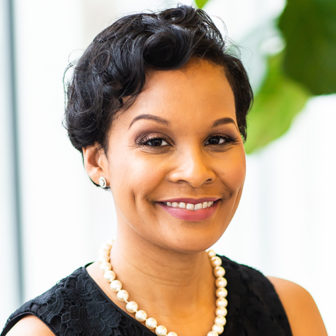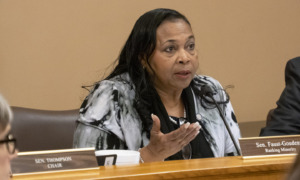
Monkey Business Images/Shutterstock
.
Access to post-secondary education is a common goal for many adolescents. Appropriate assistance from a knowledgeable adult is critical for successful navigation of the challenging post-secondary education preparation process, therefore vital in achieving access to higher education. Unfortunately, foster care youth experience barriers when it comes to educational attainment, making it more difficult to achieve as compared to their counterparts.

Regina Williams
According to research, only about 10% of youth who were formerly in foster care enrolled in college, and only 4% of these youth obtained a bachelor’s degree. Moreover, foster care adolescents are more likely to not complete high school, be suspended or expelled, or repeat a grade level. With minimal support, it is estimated that only one-third of foster care youth who have aged out had a driver’s license, basic necessities or money upon leaving the foster care system. Additionally, little is known about foster youth’s readiness to engage in post-secondary education, their developmental needs during their college transition and ways that higher education professionals and the child welfare system can offer support.
Regardless of these barriers, many foster care youth aspire to pursue a post-secondary school education. Unfortunately, these numerous challenges such as school instability, low academic preparation and lack of support networks can impede their potential for achieving these educational aspirations. Thus, career and college readiness interventions that help foster care adolescents prepare for post-secondary education attainment must be introduced.
The 4 factors
Professionals seeking to enhance the career and college readiness of adolescents aging out of foster care can use the four factors of the Career and College Readiness Self-Efficacy Inventory (CCRSI).
The CCRSI is a measure of an individual’s strength of belief in their readiness to begin studies in a career pathway and their preparedness for success in entry-level post-secondary education settings. The CCRSI consists of 14 statements. Respondents are directed to choose one of five responses ranging from 1 (strongly disagree) to 5 (strongly disagree). The inventory contains a four-factor model that encompasses the following areas: (a) College knowledge: meeting procedural and financial challenges associated with post-secondary education and future careers; (b) Positive personal characteristics: possessing positive personal characteristics that will enhance readiness; (c) Academic competence: believing that one possesses the competencies needed to be successful in the future; and (d) Potential to achieve future goals: believing that one has the potential to set and achieve future goals. Administering the CCRSI to foster care adolescents and then developing interventions that help them improve in these four domains can in turn enhance their career and college readiness self-efficacy.
Career & College Readiness Interventions
College knowledge: There is a need for college knowledge to ensure students attain a post-secondary education. It is described as students understanding (a) the admission selections process, (b) ways to financially afford post-secondary education, (c) academic requirements for work on the college level and (d) cultural differences in the respective post-secondary education settings. Examples of college knowledge strategies include introducing career planning and assessment tools (e.g. Holland Code assessment, career clusters activity, O*NET), and demystifying the college application and planning process using information on College Board and Commonapp.
Professionals can also help foster care adolescents by creating with them a post-secondary education worksheet about the post-secondary institutions they’re interested in. They would work together to explore the following characteristics: 1) college/university facts (i.e. location, population, demographic percentages, housing, etc.); 2) Admissions requirements (i.e. minimum GPA and SAT/ACT scores, high school courses, essays, specific major department requirements, etc.); 3) Application deadlines for admission; 4) Departmental information for desired major (i.e. college of education information, school of business information, etc.); 4) Scholarships and deadlines; and 5) Designated school visitation days. As a homework activity, professionals can ask foster care adolescents to write down three reasons why they want to attend each post-secondary institution they researched. They can also ask them to write down three to five questions they would like to ask a college admissions counselor from their chosen institutions.
It’s also important for professionals to help foster care adolescents navigate post-secondary education affordability. Introducing them to educational training vouchers (ETV), the different types of financial aid (i.e. gift aid vs. self-help aid) and information needed to complete the Free Application for Federal Student Aid (FAFSA) are focus areas for funding. Another effort would be to engage them in a National Association for College Admission Counseling (NACAC) College Fair. Attendees at a NACAC college fair can interface with college admissions counselors and attend workshops geared toward applying for financial aid and the college application process. The goal here is to make the college-going experience more realistic for foster care adolescents.
Positive personal characteristics is described as having a support network of influential people who can motivate one to reach goals and achieve success, as well as feeling confident in one’s ability to live a good life in the future. For support networks to be effective, bidirectional relationships must be created between the support services, the children and their families. Professionals are challenged to create effective bidirectional relationships between themselves and other members of their foster care youth’s support networks to both fully understand and facilitate their post-secondary educational needs. To accomplish this, identifying individuals in their support networks and ways they can support their post-secondary goal attainment is essential. Since the literature indicates foster care youth often have a lack of support networks, the professional may have to identify other influential people (e.g. social worker, guardian et litem, etc.) or educational support programs (e.g. TRIO programs, social services programs, etc.) that can appropriately assist their youth with this goal.
Academic competence refers to academic preparation situations such as knowing how to successfully read a textbook, prepare for a test and take appropriate class notes. An example of a strategy is a bingo game that can help foster care adolescents identify various study skills and discuss how utilizing them can enhance their academic success. Professionals can then help their youth identify which study skills can keep them on track toward high school graduation. Learning appropriate time management skills is also an important component for academic success. Foster care adolescents must recognize how they are currently spending their time weekly and how much is being dedicated toward academic preparation. Professionals must then help them improve their time management in three specific areas: a) identifying obligated time, b) identifying free time and c) analyzing their situation. Connecting this intervention back to post-secondary attainment, professionals can ask foster care adolescents how learning time management skills can assist them in achieving their post-secondary goals.
Potential to achieve future goals involves believing one can succeed with the appropriate post-high school education situation and believing how a post-high school education can help one achieve life and career goals. Professionals can help foster care adolescents set goals toward post-secondary education attainment by helping them create an Individual Learning Plan. With the ILP, the professional and foster care adolescent can work together to brainstorm and identify various career and college readiness activities and resources, then select and sequence those that are deemed the most promising. The ILPs can be reviewed on a weekly basis to check the youth’s progress toward completing activities and identifying barriers to accomplishing the established goals.
It takes a whole village to raise a child is an African proverb that means that the upbringing of a child is a communal effort. This saying is especially true for foster care adolescents who must successfully navigate their way to post-secondary education attainment. This will not be possible without assistance from a strong support network and tools that will ensure their success. As professionals become more aware of the educational needs of foster care adolescents, they can play a lead role in their support networks and customize interventions that can enhance their career and college readiness self-efficacy.
Regina Gavin Williams is a clinical assistant professor of counselor education and program coordinator of higher education administration at North Carolina Central University. Her research focuses on the career and college readiness and adult self-sufficiency of adolescents aging out of the foster care system.





























